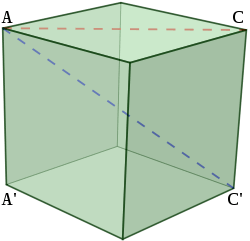Space diagonal
In geometry a space diagonal (also interior diagonal or body diagonal) of a polyhedron is a line connecting two vertices that are not on the same face. Space diagonals contrast with face diagonals, which connect vertices on the same face (but not on the same edge) as each other.[1]

For example, a pyramid has no space diagonals, while a cube (shown at right) or more generally a parallelepiped has four space diagonals.
Axial diagonal
An axial diagonal is a space diagonal that passes through the center of a polyhedron.
For example, in a cube with edge length a, all four space diagonals are axial diagonals, of common length More generally, a cuboid with edge lengths a, b, and c has all four space diagonals axial, with common length
A regular octahedron has 3 axial diagonals, of length , with edge length a.
A regular icosahedron has 6 axial diagonals of length , where is the golden ratio .[2]
Space diagonals of magic cubes
A magic square is an arrangement of numbers in a square grid so that the sum of the numbers along every row, column, and diagonal is the same. Similarly, one may define a magic cube to be an arrangement of numbers in a cubical grid so that the sum of the numbers on the four space diagonals must be the same as the sum of the numbers in each row, each column, and each pillar.
See also
- Distance
- Face diagonal
- Magic cube classes
- Hypotenuse
- Spacetime interval
References
- William F. Kern, James R Bland,Solid Mensuration with proofs, 1938, p.116
- Sutton, Daud (2002), Platonic & Archimedean Solids, Wooden Books, Bloomsbury Publishing USA, p. 55, ISBN 9780802713865.
- John R. Hendricks, The Pan-3-Agonal Magic Cube, Journal of Recreational Mathematics 5:1:1972, pp 51–54. First published mention of pan-3-agonals
- Hendricks, J. R., Magic Squares to Tesseracts by Computer, 1998, 0-9684700-0-9, page 49
- Heinz & Hendricks, Magic Square Lexicon: Illustrated, 2000, 0-9687985-0-0, pages 99,165
- Guy, R. K. Unsolved Problems in Number Theory, 2nd ed. New York: Springer-Verlag, p. 173, 1994.